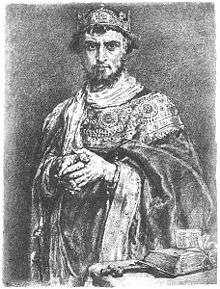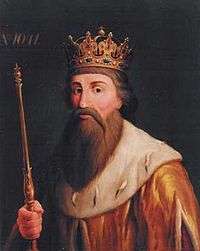Casimir I the Restorer
| Casimir I the Restorer | |
|---|---|
| Duke of Poland | |
|
Portrait by Aleksander Lesser. | |
| Reign | Duke: 1040–1058 |
| Predecessor | Mieszko II Lambert |
| Successor | Bolesław II the Bold |
| Born |
25 July 1016 Kraków, Poland |
| Died |
28 November 1058 (aged 42) Poznań, Poland |
| Burial | Archcathedral Basilica of St. Peter and St. Paul, Poznań |
| Wife | |
| Issue |
With Maria Dobroniega : Bolesław II the Bold Władysław I Herman Mieszko Otto Świętosława, first Queen of Bohemia |
| Dynasty | Piast dynasty |
| Father | Mieszko II Lambert |
| Mother | Richeza of Lotharingia |
Casimir I the Restorer (Polish: Kazimierz I Odnowiciel; b. Kraków, 25 July 1016 – d. Poznań, 28 November 1058), was Duke of Poland of the Piast dynasty and the de jure monarch of the entire country from 1034 until his death.
He was the only son of Mieszko II Lambert by his wife Richeza, daughter of Count Palatine Ezzo of Lotharingia (of the Ezzonids) and granddaughter of Emperor Otto II.
Casimir is known as the Restorer because he managed to reunite all parts of the Polish Kingdom after a period of turmoil. He reinstated Masovia, Silesia and Pomerania into his realm. However, he failed to crown himself King of Poland, mainly because of internal and external threats to his rule.
Life
Early years

Relatively little is known of Casimir's early life. He must have spent his childhood at the royal court of Poland in Gniezno. In order to acquire a proper education, he was sent to one of the Polish monasteries in 1026. According to some older sources he initially wanted to have a career in the Church (it is probable that he held the post of oblate) and even asked for a dispensation to become a monk. This hypothesis, however, is not supported by modern historians. Regardless, he left church work for good in 1031.
Rule of his father, Mieszko II

Casimir's father, Mieszko II, was crowned King of Poland in 1025 after the death of his father Bolesław I the Brave. However, the powerful magnates of the country feared a strong central government like the one that existed under Bolesław I's rule. This led to considerable friction between the King and the nobility. Taking advantage of the King's precarious situation, Mieszko II's older half-brother Bezprym and younger brother Otto turned against him and allied themselves with the Holy Roman Emperor Conrad II, whose forces attacked Poland and regained Lusatia. Years of chaos and conflict followed, during which Mieszko II was forced to cede the throne to Bezprym in 1031, fled to Bohemia, was imprisoned by Duke Oldřich and castrated, returned to rule a portion of the kingdom, eventually regained the kingdom, and then died in May 1034 under suspicious circumstances.
Sometime during the reign of Bezprym, Casimir and his sisters were taken by their mother to Germany (her native land) for refuge. It has been reported that Queen Richeza brought the Polish royal crown and regalia to Emperor Conrad II at Bezprym's request to indicate his acceptance of the primacy of his western neighbor,[1] although the Queen could have taken them for safekeeping, or they could have been brought to the Emperor by another means. At the time of his father's death in 1034, Casimir was about 18 years old and in Germany at the court of his uncle Hermann II, Archbishop of Köln.
Interregnum
The central district of Greater Poland (Wielkopolska) revolted against the nobles and Catholic clergy in a mass rebellion. A pagan revival in the area lasted for several years. The district of Masovia seceded and a local lord, Miecław, formed a state of his own. A similar situation occurred in Pomerania.
In 1037 both the young prince and his mother returned to Poland and attempted to seize the throne. This precipitated a rebellion by local barons, which coupled with the so-called "Pagan Reaction" of the commoners, forced Casimir and Richeza to flee to Saxony. However, soon Casimir returned to Poland and in 1038, once again, tried to regain power with the aide of his influential mother. This also failed and he had to flee again, this time to the Kingdom of Hungary where he was imprisoned by Stephen I. The Dowager Queen remained in Germany as a nun until her death, in 1063.
Taking advantage of the chaos and his neighbour's weakness, Duke Bretislaus I of Bohemia invaded and ravaged the country in 1039. Lesser and Greater Poland were severely pillaged, Poznań was captured, and Bretislaus sacked Gniezno, taking the relics of Saint Adalbert, Radim Gaudentius, and the five hermit brothers[2] with him. On the way back he conquered part of Silesia, including Wrocław, destroyed religious buildings which were built by Mieszko I during the feast of the conversion of Poland, and plundered Mieszko I's tomb.
Restoration

After initially escaping to Hungary, Casimir went to Germany, where in 1039 his relative the Emperor Henry III (who feared the increased power of the Bohemian ruler) gave him military and financial support. Casimir received a force of 1,000 heavy footmen and a significant amount of gold to restore his power in Poland. Casimir also signed an alliance with Yaroslav I the Wise, the Prince of Kievan Rus', who was linked with him through Casimir's marriage with Yaroslav's sister, Maria Dobroniega. With this support, Casimir returned to Poland and managed to retake most of his domain. In 1041, Bretislaus, defeated in his second attempted invasion by Emperor Henry III, signed a treaty at Regensburg (1042) in which he renounced his claims to all Polish lands except for Silesia, which was to be incorporated into the Bohemian Kingdom.[3] It was Casimir's success in strengthening royal power and ending internal strife that earned him the epithet of "the Restorer".
The treaty gained Casimir a period of peace on the southern border and the capital of Poland was moved to Kraków, the only major Polish city relatively untouched by the wars. It is probable that the Holy Roman Emperor was pleased with the balance of power that had been restored to the region and forced Casimir not to crown himself the King of Poland. In 1046 Emperor Henry III held royal and imperial courts at Merseburg and Meissen, at which he ended the strife among the Duke of Pomerania (Dux Bomeraniorum), Duke Bretislaus of Bohemia, and Casimir I.
In 1047 Casimir, aided by his Kievan brother-in-law, started a war against Masovia and seized the land. It is probable that he also defeated Miecław's allies from Pomerania and attached Gdańsk to Poland. This secured his power in central Poland. Three years later, against the will of the Emperor, Casimir seized Bohemian-controlled Silesia, thus securing most of his father's domain. In 1054 in Quedlinburg, the Emperor ruled that Silesia was to remain in Poland in exchange for a yearly tribute of 117 kg. of silver and 7 kg. of gold.
At that time Casimir focused on internal matters. To strengthen his rule he re-created the bishopric in Kraków and Wrocław and erected the new Wawel Cathedral. During Casimir's rule heraldry was introduced into Poland and, unlike his predecessors, he promoted landed gentry over the drużyna as his base of power. One of his reforms was the introduction, to Poland, of a key element of feudalism: the granting of fiefdoms to his retinue of warriors, thus gradually transforming them into medieval knights.
Marriage and issue
Casimir married Maria Dobroniega (ca. 1012–1087), daughter of Grand Duke Vladimir I of Kiev.[4] There is no consensus among historians as to when it took place. Władymir D. Koroliuk said that it was in 1039, Aleksej A. Szachmatow and Iwan Linniczenko agreed on 1041, while Dymitr S. Lichaczew postulated that it occurred during 1043.[5]
Casimir and Maria had five children:
- Bolesław II the Bold (ca. 1043 – 2/3 April 1081/82).
- Władysław I Herman (ca. 1044 – 4 June 1102)
- Mieszko (16 April 1045 – 28 January 1065).
- Otto (ca. 1046–1048).
- Świętosława (ca. 1048 – 1 September 1126), married ca. 1062 to Duke (from 1085, King) Vratislaus II of Bohemia.[6]
Ancestry
| Ancestors of Casimir I the Restorer | ||||||||||||||||||||||||||||||||||||||||||||||||||||||||||||||||||||||||||||||||||||||||||||||||||||||||||||||||||||||||||||||||||||||||||||||||||||||||||||||||||||||||||||||||||||||||||||||||||||||||||||||||||||||||||||||||||||||||||||||||||||||||||||||||||||||||||||||||||||||||||||||||||||||||||||||||||||||||||||||||||||||||||||||||||||||||||||||||||||||||||||||||||||||||||||||||||||||||||||||||||||||||||||||||||||||||||||||||||||||||||||||||||||||||||||||||
|---|---|---|---|---|---|---|---|---|---|---|---|---|---|---|---|---|---|---|---|---|---|---|---|---|---|---|---|---|---|---|---|---|---|---|---|---|---|---|---|---|---|---|---|---|---|---|---|---|---|---|---|---|---|---|---|---|---|---|---|---|---|---|---|---|---|---|---|---|---|---|---|---|---|---|---|---|---|---|---|---|---|---|---|---|---|---|---|---|---|---|---|---|---|---|---|---|---|---|---|---|---|---|---|---|---|---|---|---|---|---|---|---|---|---|---|---|---|---|---|---|---|---|---|---|---|---|---|---|---|---|---|---|---|---|---|---|---|---|---|---|---|---|---|---|---|---|---|---|---|---|---|---|---|---|---|---|---|---|---|---|---|---|---|---|---|---|---|---|---|---|---|---|---|---|---|---|---|---|---|---|---|---|---|---|---|---|---|---|---|---|---|---|---|---|---|---|---|---|---|---|---|---|---|---|---|---|---|---|---|---|---|---|---|---|---|---|---|---|---|---|---|---|---|---|---|---|---|---|---|---|---|---|---|---|---|---|---|---|---|---|---|---|---|---|---|---|---|---|---|---|---|---|---|---|---|---|---|---|---|---|---|---|---|---|---|---|---|---|---|---|---|---|---|---|---|---|---|---|---|---|---|---|---|---|---|---|---|---|---|---|---|---|---|---|---|---|---|---|---|---|---|---|---|---|---|---|---|---|---|---|---|---|---|---|---|---|---|---|---|---|---|---|---|---|---|---|---|---|---|---|---|---|---|---|---|---|---|---|---|---|---|---|---|---|---|---|---|---|---|---|---|---|---|---|---|---|---|---|---|---|---|---|---|---|---|---|---|---|---|---|---|---|---|---|---|---|---|---|---|---|---|---|---|---|---|---|---|---|---|---|---|---|---|---|---|---|---|---|---|---|---|---|---|---|---|---|---|---|---|---|---|---|---|---|---|---|---|---|---|---|---|---|---|---|---|---|---|---|---|---|---|---|---|---|---|---|---|---|---|---|---|---|---|---|---|---|---|---|---|---|---|---|---|---|---|---|---|---|---|---|---|---|---|---|
| ||||||||||||||||||||||||||||||||||||||||||||||||||||||||||||||||||||||||||||||||||||||||||||||||||||||||||||||||||||||||||||||||||||||||||||||||||||||||||||||||||||||||||||||||||||||||||||||||||||||||||||||||||||||||||||||||||||||||||||||||||||||||||||||||||||||||||||||||||||||||||||||||||||||||||||||||||||||||||||||||||||||||||||||||||||||||||||||||||||||||||||||||||||||||||||||||||||||||||||||||||||||||||||||||||||||||||||||||||||||||||||||||||||||||||||||||
See also
| Wikimedia Commons has media related to Casimir I of Poland. |
Notes
- ↑ Boshof, Egon (2008). Die Salier (in German) (5th ed.), p. 71. Kohlhammer. ISBN 3-17-020183-2.
- ↑ Smith, Richard Upsher, Jr. Hermit Life. Camaldolese spirituality: essential sources. Touchstone, Jan/Feb 2008. Accessed on Jan 2, 2015 at www.touchstonemag.com/archives/article.php?id=21-01-050-b. Note that the reference cites the existence of the five hermit brothers in Poland ("Bruno’s “Life of the Five Hermit Brothers,” written to promote the canonization of Romuald’s disciples martyred in pagan Poland in 1004,..."), not the theft of their relics by Bretislaus I.
- ↑ Kosmas: Chronicle of the Czechs, Warsaw 1968, p. 154, note. 18, says that the rest of Silesia, included the left side of the Odra River in Wrocław and Opole remained in Bohemia; by the other hand, T. Jurek: Ryczyn biskupi, Roczniki historyczne 1994, pp. 40–44, believes that already in 1041 Poland regained the control over the rest of Silesia included land of Golensizi tribe.
- ↑ Robert-Henri Bautier, Anne de Kiev, Reine de France, et la Politique Royale au XI E SIÈCLE: Étude Critique De La Documentation. Revue Des études Slaves 57, no. 4 (1985): 545.
- ↑ Krzysztof Benyskiewicz, Książę Polski Władysław I Herman 1079–1102, Zielona Góra 2010, s. 34.
- ↑ Knoll & Schaer 2003, p. 82.
References
- Gesta principum Polonorum:The Deeds of the Princes of the Poles. Translated by Knoll, Paul W.; Schaer, Frank. Central European University Press. 2003.
| Casimir I the Restorer Piast Dynasty Born: 25 July 1016 Died: 28 November 1058 | ||
| Preceded by Mieszko II Lambert |
Duke of Poland 1038–1058 with interruptions until 1040 |
Succeeded by Bolesław II the Bold |